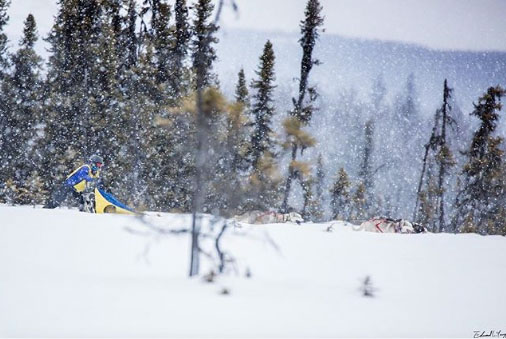
“No one really knows how I got into it — I was raised in Connecticut where there isn’t much mushing and my parents don’t even like dogs,” Grenier said. “Eventually though, they broke down and let me get a team. I was immediately hooked.”
Now Grenier works to impart that same excitement and passion for dog sledding to students at Alaska Pacific University during her spring semester Dog Mushing course in the Outdoor Studies Department.
While titled Dog Mushing, is really an introduction to several types of dog powered sports. Over the course of the semester, the class volunteered at both the Fur Rondy World Championship and the Iditarod, so they students could see both sprint and distance mushing; they heard recreational mushers talk about the ways they mush that have nothing to do with racing; and they learned about skijoring and dryland racing.
The reasoning behind covering the various types of dog sports is to introduce students to the different styles and to help them build connections within the mushing community, should they want to learn more or pursue that discipline.
“I hope in doing so, the students learn that you don’t need 50 dogs to be a musher,” Grenier said. “There are lots of ways to be competitive or just to have fun with dog powered sports even if you just have a few dogs.”
The class also spent a lot of time talking about dog care, Grenier said, as having an understanding of how to maintain health dogs with the best care possible is important for any mushing style.
“Learning to mush is so much more than just staying on the sled,” Grenier said. “You have to learn how to read the dogs and give them what they need to be successful. I’ve been mushing for 16 years and am still learning all the time.”
Grenier said for her the drive to mush is her dogs drive to run. Most of her dogs are rescues or dogs that are not necessarily the type other mushers are looking for.
“I love taking the misfits, figuring out their quirks, and watching them shine,” Grenier said. “Building a good team is like putting together a puzzle.”
Her kennel is comprised of 12 dogs, most of which are hound mixes, not the huskies more commonly associated with sled dogs.
“The dogs used for sprint mushing are very different than those used for distance mushing, which makes sense because they are very different sports,” Grenier explained.
Grenier primarily competes in dryland and sprint races. Of her dozen dogs, she picks her racing team from the core seven: Panther, Athena, Diamond, Memphis, Oliver, Fenway, and Epic. Occasionally, she runs recreationally with Nikiski, Kaya, and Tantrum. The remaining two are her designated hiking buddy, Hazmat, and a Mastiff named Cujo. All 12 dogs live in her home.
“It is one of the reasons I love sprint mushing,” Grenier said. “I can be really competitive even with a small kennel.”
